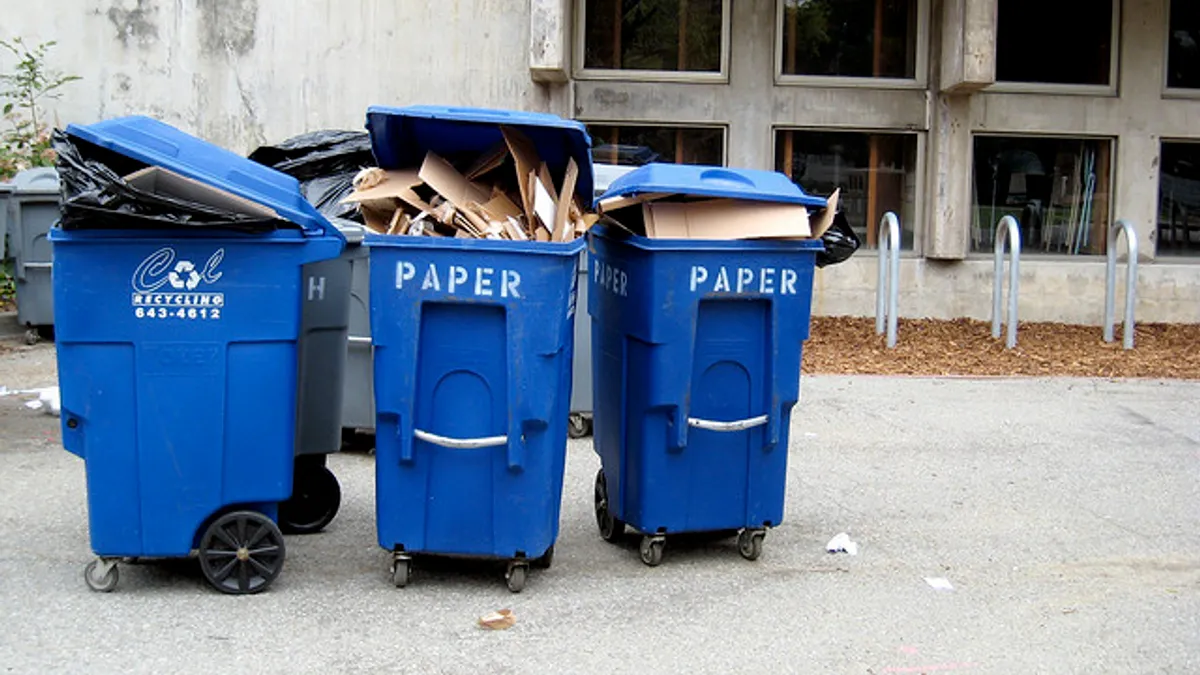From 2009 to 2012, most recycling markets were rocking — but as consumer trends come and go, so do profits.
For the past three years, devalued materials and higher operation costs have driven plant shut downs and, at the very least, decreased investments from some companies.
Conversely, other companies are pumping more money into the industry while commodities are cheap, hoping for a turnaround.
Other trends are rising from rocky times, like exploration into new markets, or new business models and partnerships to share the impact of negative revenue. The goal is to preserve an industry that, in and of itself, is about preservation. An industry that, through ups and downs, has generated billions in revenue, employs tens of thousands, and reduces carbon footprints.
Long supply; short demand
"What we have today, due to recycling legislation in most states, is a supply that never stops, regardless of demand," said Chaz Miller, director of policy/advocacy for the National Waste and Recycling Association (NWRA).
Paper is a prime example. The commodity hit an all-time peak in 2010, but if you look back since 2002, use of what was once the mother’s milk for municipal recycling has dropped by 20 million tons.
"That had an incredible impact on recycling processing plants, which were built to handle this commodity," said Miller, attributing the downward spiral to two factors: the Internet explosion, which made "paperwork" near obsolete, and China’s smoldering manufacturing industry, which ended their mega volume investment in paper to feed mills and for packaging.
With single stream-recycling, more uncrecyclables are getting tossed, therefore companies must manually pull and clean what’s salvageable. They pay to landfill remaining contaminants, and pay for what has gummed up their equipment.
Companies and municipalities that have the cash are investing in high-tech scanners and sorters, which Miller believes saves money in the end. In late 2015, Republic Services opened a $35 million recycling center in Las Vegas with all the bells and whistles to combat contamination. In 2016, Dallas will build a $20 million materials recovery facility.
Allocating risk
More than 2,000 municipalities pay to dispose of their recyclables by some reports, and businesses of all sizes are looking for ways to absorb the financial shock. Texas-based Waste Management’s recycling division lost nearly $16 million in the first quarter of 2015, and by last June had shut down nearly one in 10 of its biggest recycling facilities. Smaller companies typically feel the loss even more.
In some cases, municipalities and private haulers with no processing facilities share revenues, as well as risk. Vermont-based Casella Waste Systems has a recycling fee, which floats as a percentage of their customers’ bills, based on the markets. Other companies charge flat fees, assuming all risk but charging more per ton than with other fee models.
To help ease some of the burdens on recyclers, a group of the world’s largest manufacturers and retailers launched the Closed Loop Fund, providing zero interest loans to cities and below market loans to companies to pump the recycling infrastructure. With the Closed Loop Fund, cities have access to capital, and recycling companies can take risks that banks won’t finance.
Looking for new markets
Some commodities spaces are opening up.
Polyethylene terephthalate (PET) use recently hit a short-term record high in the U.S., increasing from 1.513 billion pounds in 2013 to 1.564 billion pounds in 2014. Still, its value is low, with prices hitting 3 cents to 5 cents per pound in December 2015.
Post-consumer HDPE prices have been steady or climbing, especially colored HDPE. But processing plastics can be a high-maintenance job. The material must be sorted; bottle caps commonly fall through cracks in machinery; and some waste is hard to work with as it is composed of multiple layers of plastics.
Still, said Miller, "It’s a good time to invest in plastic because supply will continue to increase as the use of plastics increases."
QRS of Maryland is counting on this trend. In 2015 the company opened a $15 million recycling facility in Dundalk to separate post-consumer plastics by resin type. Additionally, the city of Austin, TX plans to create a brand new market—or a marketplace. The city is investing $7.5 million in a [re]Manufacturing Hub, inviting recycling and reuse manufacturers to make new products from the city’s recyclables.
Ohio-based Rumpke is working to cash in on what many consider one of the industry’s worst nightmares: glass. The company has invested over $5 million in a new glass recycling plant since its launch in 2003, putting money toward high-dollar technology like screening equipment for glass processing. Steve Sargent, Rumpke’s director of recycling, says the market looks promising, especially in fiberglass.
Educating customers is key
Consumers generally toss what they assume is recyclable, without realizing this is not the last step in the process, and this needs to change, said Miller. NWRA, Keep America Beautiful, the Solid Waste Association of North America (SWANA), and the Environmental Protection Agency (EPA) are partnering to educate the public on what can go into the stream. And these groups say municipalities and haulers should remind people, recycling is not free.
"Plan for ups and downs; it’s part of business," said Miller. "What we are dealing with now, and it is not a new phenomenon for municipal recycling, is the issue of figuring out how to share the risk of negative revenue."






















